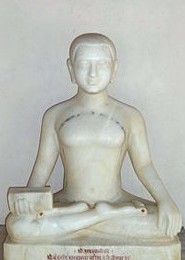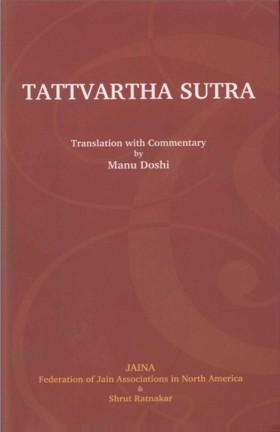09.06 Uttamah Kshamāmārdavārjavshauchsatyasany-amtapastyāgākinchanyabrahmacharyāni Dharmah
Audio: Sanskrit: उत्तमः क्षमामार्दवार्जवशौचसत्यसंयम- तपस्त्यागाकिञ्ञचन्यब्रह्मचर्याणि धर्मः ।
Hindi: क्षमा, मार्दव, आर्जव, सत्य, संयम, तप, त्याग, आकिंचन्य, और ब्रह्मचर्य उत्तम धर्म हैं।
09.06
English: Forgiveness, mildness, straightforwardness, purity, truth, self-restraint, austerity, renouncing, absence of possession and celibacy constitute the topmost religion.
This sutra stipulates the following ten attributes as the topmost religion.
- Kshamā:
This denotes forgiveness. That necessitates the spirit of forbearance. During the life we come across many occasions, when we fee! hurt by the action or utterance of someone. In that case we are prone to nurse grudge or maintain animosity towards that person. If it is within our power, we may even try to hurt him. But that would prompt him to treat us in a worse manner and then we may try to retaliate. Thus animosity would continue to grow on either side and there would be no end to it. The better way would be to patiently consider whether there was any justification for that person's initial action. If it was prompted by our own fault, we should feel obliged that he pointed out our fault. In that case there would not be any reason to hold grudge against him.
If we do not find his action justifiable, we should attribute it to some of our past Karma, which prompted him to behave that way. We should therefore bear it with equanimity. That would lead to the termination of that Karma and would not give rise to animosity on either side. Forgiveness is thus the most essential attribute of religion. It is a great virtue. As such, Jainism lays maximum emphasis on that. Its motto is 'Kshamā Virasya Bhooshanam' which means that forgiveness is the adornment of the brave. On that very account we celebrate Samvatsari as a forgiving Parva.
- Mārdav:
This means Mrdutā, which is derived from Mrdu and denotes mildness, humbleness etc. It is a prerequisite for forbearance, because it would not be possible to resort to forbearance without developing mildness. This attribute is the antithesis of ego, arrogance and disdain, which are the causes of defilement. They arise from the sense of superiority in respect of caste, status, wealth, knowledge, health, beauty etc. and need to be averted. That can be done by cultivating mildness and humbleness. As such, Mrdutā also is a great virtue, which one should try to develop to the extent possible.
- Arjav:
This denotes straightforwardness. It is the antithesis of Māyā, which denotes crookedness, deceit, duplicity etc. The straightforwardness denotes sincerity and honesty of purpose. That can be achieved by bringing forth uniformity in exercising the faculties of mind, speech and body. In other words, one should maintain consistency in his thought, speech and action, provided that they are for wholesome purposes.
- Shauch:
This literally means cleanliness. Here, however, it has been used in the sense of removal of attachment that pollutes the soul. The attachment could be for persons or objects and could be admirable or otherwise. It is easy to make out that one should avoid attachment for the undesirable aspects. But the concept of Shauch stipulates that one should not have attachment even for the admirable ones. In other words, one should develop external as well as interna) detachment.
- Satya:
This denotes truthfulness. Usually it is taken in the sense of not telling lies. But that merely denotes the verbal truth, which is not enough for maintaining truthfulness. One should have truthful approach as well. While resorting to verbal truth, if one harbors within his mind evil or wrong motive, he cannot be said to be truthful. Moreover, if the verbal truth happens to be hurtful to anyone, it has to be avoided. Similarly one needs to avoid ambiguity. Satya should therefore be clear, helpful and agreeable. That is presented in the motto of Satyam, Shivam, Sundaram.
- Sanyam;
This denotes self-control, self-regulation, self restraint etc. It is of 17 types, viz. restraining of five sense organs, observance of five major restraints, overcoming of four defilements and restraining of mental, verbal and physical faculties. In short, Sanyam stipulates refraining from every activity that hurts true Self. For all practical purposes, observance of Gupties and Samities amounts to Sanyam.
- Tap:
This denotes observance of austerities so as to gain self-control and strength for overcoming the defiling tendencies. This aspect is going to be considered in sutras 19 to 26.
- Tyāg:
This denotes renouncing, sacrificing, giving up, etc. It can be of two types, external and internal. Giving up the worldly possessions is external renouncing. That does not consist of merely giving up some tangible object; it should also cover giving up of power, authority, influence etc. While giving up, one should not experience the strain of renouncing; he should not feel that he has to give up. It should be done willingly in the interest of others and should occur naturally. Giving up attachment for sense objects and overcoming of craving, aversion, anger, animosity, arrogance etc. constitute internal renouncing.
- Akinchanya:
This denotes absence of possessions. It is a refinement of renouncing. If one gives up the physical possessions, but retains attachment towards the same, it is not going to serve the purpose. More emphasis should be laid on giving up the sense of belonging than on giving up the tangibles. Moreover, the term Akinchanya also denotes nothing but the soul. It means that one needs to give up everything that does not pertain to soul. In other words, one should stay completely tuned to the soul.
- Brahmacharya:
This is usually understood as observance of celibacy. But the term Brahmacharya literally means staying within the Self. When one stays tuned to the soul, he cannot even think of indulging in sexual pleasure. The physical celibacy is therefore an outcome of observing true Brahmacharya.
These ten characteristics are collectively called Dashlaxanā Dharma.
 Acharya Umaswati
Acharya Umaswati
